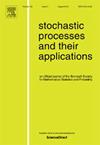Harmonizable Multifractional Stable Field: Sharp results on sample path behavior
IF 1.2
2区 数学
Q3 STATISTICS & PROBABILITY
引用次数: 0
Abstract
For about three decades now, there is an increasing interest in study of multifractional processes/fields. The paradigmatic example of them is Multifractional Brownian Field (MBF) over , which is a Gaussian generalization with varying Hurst parameter (the Hurst function) of the well-known Fractional Brownian Motion (FBM). Harmonizable Multifractional Stable Field (HMSF) is a very natural (and maybe the most natural) extension of MBF to the framework of heavy-tailed Symmetric -Stable (SS) distributions. Many methods related with Gaussian fields fail to work in such a non-Gaussian framework, this is what makes study of HMSF to be difficult. In our article we construct wavelet type random series representations for the SS stochastic field generating HMSF and for related fields. Then, under weakened versions of the usual Hölder condition on the Hurst function, we obtain sharp results on sample path behavior of HMSF: optimal global and pointwise moduli of continuity, quasi-optimal pointwise modulus of continuity on a universal event of probability 1 not depending on the location, and an estimate of the behavior at infinity which is optimal when the Hurst function has a limit at infinity to which it converges at a logarithmic rate.
可调和多分数稳定场:关于样本路径行为的尖锐结果
近三十年来,人们对多分数过程/场的研究越来越感兴趣。它们的典型例子是RN上的多分数布朗场(MBF),它是著名的分数布朗运动(FBM)的变化赫斯特参数(赫斯特函数)的高斯推广。调和多重分数稳定场(HMSF)是MBF在重尾对称α-稳定(s - α s)分布框架下的一个非常自然的(也许是最自然的)扩展。许多与高斯场相关的方法都不能在这种非高斯框架下工作,这使得HMSF的研究变得困难。本文构造了产生HMSF的s - α - s随机场及其相关场的小波型随机序列表示。然后,在Hurst函数通常Hölder条件的弱化版本下,我们得到了HMSF样本路径行为的清晰结果:最优的全局和点向连续性模量,不依赖于位置的概率为1的普遍事件上的准最优点向连续性模量,以及在无穷远处的行为估计,当Hurst函数在无穷远处有极限时,它以对数速率收敛到最优。
本文章由计算机程序翻译,如有差异,请以英文原文为准。
求助全文
约1分钟内获得全文
求助全文
来源期刊

Stochastic Processes and their Applications
数学-统计学与概率论
CiteScore
2.90
自引率
7.10%
发文量
180
审稿时长
23.6 weeks
期刊介绍:
Stochastic Processes and their Applications publishes papers on the theory and applications of stochastic processes. It is concerned with concepts and techniques, and is oriented towards a broad spectrum of mathematical, scientific and engineering interests.
Characterization, structural properties, inference and control of stochastic processes are covered. The journal is exacting and scholarly in its standards. Every effort is made to promote innovation, vitality, and communication between disciplines. All papers are refereed.
 求助内容:
求助内容: 应助结果提醒方式:
应助结果提醒方式:


